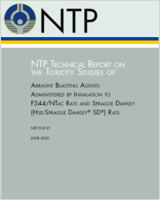This is a work of the US government and distributed under the terms of the Public Domain
NCBI Bookshelf. A service of the National Library of Medicine, National Institutes of Health.
National Toxicology Program. NTP Technical Report on the Toxicity Studies of Abrasive Blasting Agents Administered by Inhalation to F344/NTac Rats and Sprague Dawley (Hsd:Sprague Dawley® SD®) Rats: Toxicity Report 91 [Internet]. Research Triangle Park (NC): National Toxicology Program; 2020 Jun.

NTP Technical Report on the Toxicity Studies of Abrasive Blasting Agents Administered by Inhalation to F344/NTac Rats and Sprague Dawley (Hsd:Sprague Dawley® SD®) Rats: Toxicity Report 91 [Internet].
Show detailsThe National Toxicology Program (NTP), established in 1978, is an interagency program within the Public Health Service of the U.S. Department of Health and Human Services. Its activities are executed through a partnership of the National Institute for Occupational Safety and Health (part of the Centers for Disease Control and Prevention), the Food and Drug Administration (primarily at the National Center for Toxicological Research), and the National Institute of Environmental Health Sciences (part of the National Institutes of Health), where the program is administratively located. NTP offers a unique venue for the testing, research, and analysis of agents of concern to identify toxic and biological effects, provide information that strengthens the science base, and inform decisions by health regulatory and research agencies to safeguard public health. NTP also works to develop and apply new and improved methods and approaches that advance toxicology and better assess health effects from environmental exposures.
The Toxicity Report series began in 1991. The studies described in the NTP Toxicity Report series are designed and conducted to characterize and evaluate the toxicological potential of selected substances in laboratory animals (usually two species, rats and mice). Substances (e.g., chemicals, physical agents, and mixtures) selected for NTP toxicity studies are chosen primarily on the basis of human exposure, level of commercial production, and chemical structure. The interpretive conclusions presented in the toxicity reports are derived solely from the results of these NTP studies, and extrapolation of these results to other species, including characterization of hazards and risks to humans, requires analyses beyond the intent of these reports. Selection for study per se is not an indicator of a substance’s toxic potential.
NTP conducts its studies in compliance with its laboratory health and safety guidelines and the Food and Drug Administration Good Laboratory Practice Regulations and meets or exceeds all applicable federal, state, and local health and safety regulations. Animal care and use are in accordance with the Public Health Service Policy on Humane Care and Use of Laboratory Animals. Studies are subjected to retrospective quality assurance audits before they are presented for public review. Draft reports undergo external peer review before they are finalized and published.
NTP Toxicity Reports are available free of charge on the NTP website and cataloged in PubMed, a free resource developed and maintained by the National Library of Medicine (part of NIH). Data for these studies are included in NTP’s Chemical Effects in Biological Systems database.
For questions about the reports and studies, please email NTP or call 984-287-3211.
- Foreword - NTP Technical Report on the Toxicity Studies of Abrasive Blasting Age...Foreword - NTP Technical Report on the Toxicity Studies of Abrasive Blasting Agents Administered by Inhalation to F344/NTac Rats and Sprague Dawley (Hsd:Sprague Dawley® SD®) Rats
- Overview - NTP Technical Report on the Toxicity Studies of Abrasive Blasting Age...Overview - NTP Technical Report on the Toxicity Studies of Abrasive Blasting Agents Administered by Inhalation to F344/NTac Rats and Sprague Dawley (Hsd:Sprague Dawley® SD®) Rats
Your browsing activity is empty.
Activity recording is turned off.
See more...